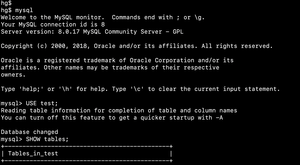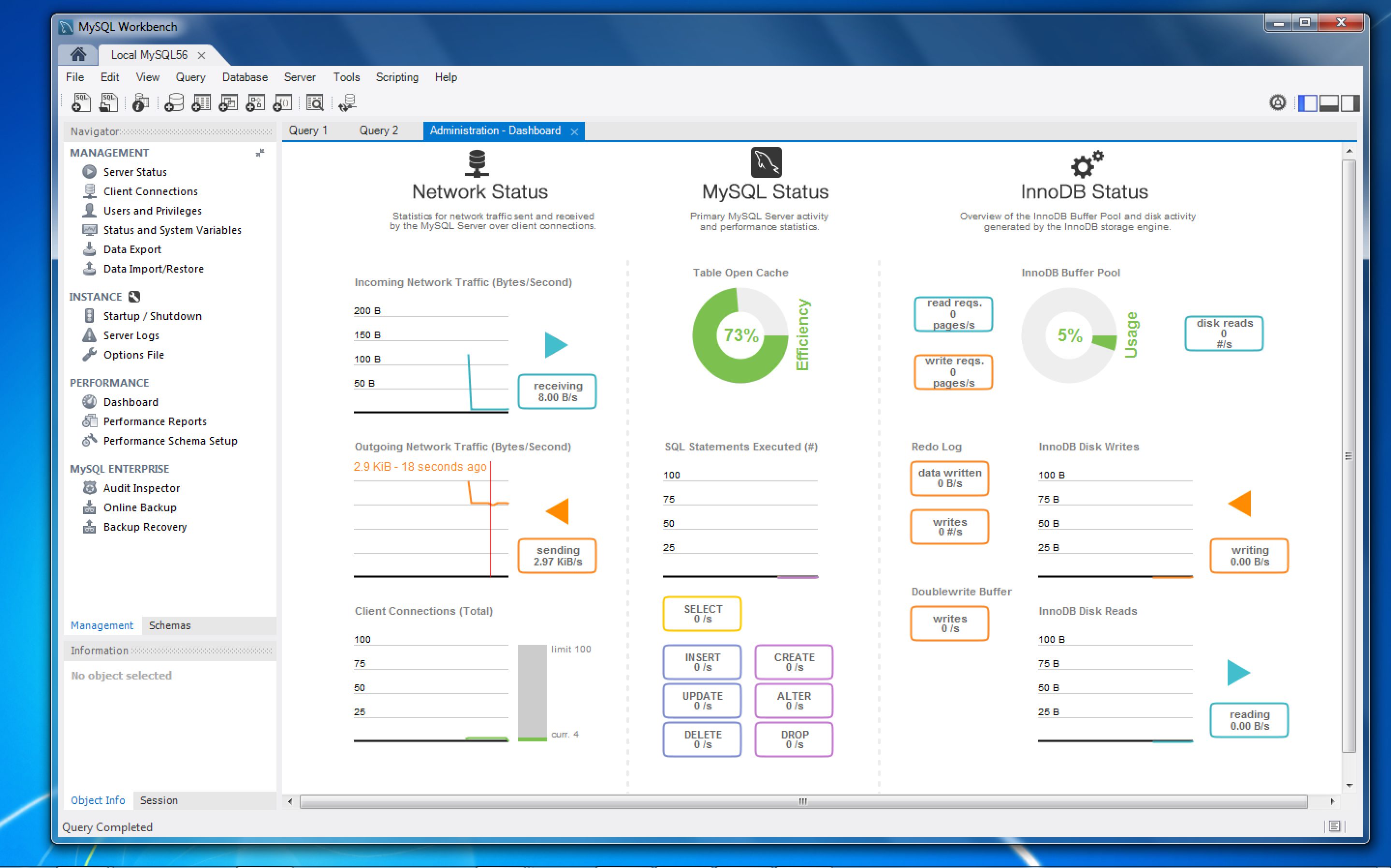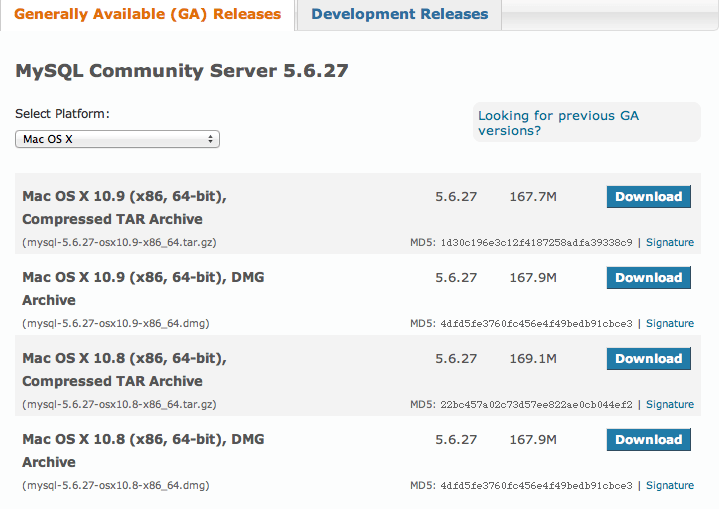The pre-installed MySQL with Mac OS X Server, MacPorts, or the official MySQL package? – Chealion Jul 19 '09 at 23:29. In general, you'll want to look in /var/log/ & /Library/Logs/ under Mac OS X Server. More specific to this issue, watch /var/log/system.log, there may be something of use in /var/mysql (like the.err log files), but I (on. My employer produces a simple, proof-of-concept HTML5-based SQL client which can be used against any ODBC data source on the web-browser host machine, through the HTML5 WebDB-to-ODBC Bridge we also produce. These components are free, for Mac, Windows, and more. Applicable to many of the other answers here - the Type 1 JDBC-to-ODBC Bridge that most are referring to is the one Sun built in to.
Recommend switching to Docker
I finally switched to using Docker for local development on macOS. While the following tutorial works for macOS Catalina, it has limitations. I recommend following my latest tutorial on installing Apache, MySQL, and PHP on macOS using Docker.
Note: This post is for new installations. If you have installed Apache, PHP, and MySQL for Mac OS Mojave, read my post on Updating Apache, PHP, and MySQL for macOS Catalina.
I am aware of the web server software available for macOS, notably MAMP, as well as package managers like brew. These get you started quickly. But they forego the learning experience and, as most developers report, can become difficult to manage.

macOS runs atop UNIX. Most UNIX software installs easily on macOS. In Additional, Apache and PHP come preinstalled with macOS. So to create a local web server, all you need to do is configure Apache and install MySQL.
Running Commands
First, open the Terminal app and switch to the root user so you can run the commands in this post without any permission issues:
Enable Apache on macOS

Verify It works! by accessing http://localhost
Enable PHP for Apache
First, make a backup of the default Apache configuration. This is good practice and serves as a comparison against future versions of macOS.
Now edit the Apache configuration. Feel free to use a different editor if you are not familiar with vi.

Uncomment the following line (remove #):
Restart Apache:
You can verify PHP is enabled by creating a phpinfo() page in your DocumentRoot.
The default DocumentRoot for macOS Catalina is /Library/WebServer/Documents. You can verify this from your Apache configuration.
Now create the phpinfo() page in your DocumentRoot:
Mysql Server For Mac Os X 10.13
Verify PHP by accessing http://localhost/phpinfo.php
Install MySQL on macOS Catalina
Download and install the latest MySQL generally available release DMG for macOS. MySQL 8 is the latest version. But older versions are available if you need to support older applications.
When the install completes it will provide you with a temporary password. Copy this password before closing the installer. You will use it again in a few steps.
Mysql Server For Mac
The README suggests creating aliases for mysql and mysqladmin. However there are other commands that are helpful such as mysqldump. Instead, you can update your path to include /usr/local/mysql/bin.
Mysql Download Mac Os
Note: You will need to open a new Terminal window or run the command above for your path to update.

Finally, you should run mysql_secure_installation. While this isn't necessary, it's good practice to secure your database. This is also where you can change that nasty temporary password to something more manageable for local development.
Connect PHP and MySQL
You need to ensure PHP and MySQL can communicate with one another. There are several options to do so. I like the following as it doesn't require changing lots of configuration:
Additional Configuration (optional)
The default configuration for Apache 2.4 on macOS seemed pretty lean. For example, common modules like mod_rewrite were disabled. You may consider enabling this now to avoid forgetting they are disabled in the future.
I edited my Apache Configuration:
I uncommented the following lines (remove #):
If you develop multiple projects and would like each to have a unique url, you can configure Apache VirtualHosts for macOS.
If you would like to install PHPMyAdmin, return to my original post on installing Apache, PHP, and MySQL on macOS.
The Macintosh computer currently have Mac OS X (Ten), version 10.6 (Snow Leopard). Early Macintosh computers ran using Motorolla Processors. When Apple changed to Power PC processors created by IBM, a third party solution via virtualization was used to. Heroes for mac os x. From Mac OS 8.1 up to Mac OS 10.4. Compatibility notes. Architecture: PPC. At least 64MB of RAM. Mac OS 8.1 - Mac OS X 10.4 (in Classic Environment) QuickTime v3.0 or newer. Game Sprockets 1.7.5 or newer (included on the install CD) Multiplayer mode requires OpenTransport 1.1.2 or newer.
Find this interesting? Let's continue the conversation on Twitter.

macOS runs atop UNIX. Most UNIX software installs easily on macOS. In Additional, Apache and PHP come preinstalled with macOS. So to create a local web server, all you need to do is configure Apache and install MySQL.
Running Commands
First, open the Terminal app and switch to the root user so you can run the commands in this post without any permission issues:
Enable Apache on macOS
Verify It works! by accessing http://localhost
Enable PHP for Apache
First, make a backup of the default Apache configuration. This is good practice and serves as a comparison against future versions of macOS.
Now edit the Apache configuration. Feel free to use a different editor if you are not familiar with vi.
Uncomment the following line (remove #):
Restart Apache:
You can verify PHP is enabled by creating a phpinfo() page in your DocumentRoot.
The default DocumentRoot for macOS Catalina is /Library/WebServer/Documents. You can verify this from your Apache configuration.
Now create the phpinfo() page in your DocumentRoot:
Mysql Server For Mac Os X 10.13
Verify PHP by accessing http://localhost/phpinfo.php
Install MySQL on macOS Catalina
Download and install the latest MySQL generally available release DMG for macOS. MySQL 8 is the latest version. But older versions are available if you need to support older applications.
When the install completes it will provide you with a temporary password. Copy this password before closing the installer. You will use it again in a few steps.
Mysql Server For Mac
The README suggests creating aliases for mysql and mysqladmin. However there are other commands that are helpful such as mysqldump. Instead, you can update your path to include /usr/local/mysql/bin.
Mysql Download Mac Os
Note: You will need to open a new Terminal window or run the command above for your path to update.
Finally, you should run mysql_secure_installation. While this isn't necessary, it's good practice to secure your database. This is also where you can change that nasty temporary password to something more manageable for local development.
Connect PHP and MySQL
You need to ensure PHP and MySQL can communicate with one another. There are several options to do so. I like the following as it doesn't require changing lots of configuration:
Additional Configuration (optional)
The default configuration for Apache 2.4 on macOS seemed pretty lean. For example, common modules like mod_rewrite were disabled. You may consider enabling this now to avoid forgetting they are disabled in the future.
I edited my Apache Configuration:
I uncommented the following lines (remove #):
If you develop multiple projects and would like each to have a unique url, you can configure Apache VirtualHosts for macOS.
If you would like to install PHPMyAdmin, return to my original post on installing Apache, PHP, and MySQL on macOS.
The Macintosh computer currently have Mac OS X (Ten), version 10.6 (Snow Leopard). Early Macintosh computers ran using Motorolla Processors. When Apple changed to Power PC processors created by IBM, a third party solution via virtualization was used to. Heroes for mac os x. From Mac OS 8.1 up to Mac OS 10.4. Compatibility notes. Architecture: PPC. At least 64MB of RAM. Mac OS 8.1 - Mac OS X 10.4 (in Classic Environment) QuickTime v3.0 or newer. Game Sprockets 1.7.5 or newer (included on the install CD) Multiplayer mode requires OpenTransport 1.1.2 or newer.
Find this interesting? Let's continue the conversation on Twitter.
For a list of macOS versions that the MySQL server supports, see https://www.mysql.com/support/supportedplatforms/database.html.
MySQL for macOS is available in a number of different forms:
Native Package Installer, which uses the native macOS installer (DMG) to walk you through the installation of MySQL. For more information, see Chapter 2, Installing MySQL on macOS Using Native Packages. You can use the package installer with macOS. The user you use to perform the installation must have administrator privileges.
Compressed TAR archive, which uses a file packaged using the Unix tar and gzip commands. To use this method, you will need to open a Terminal window. You do not need administrator privileges using this method, as you can install the MySQL server anywhere using this method. For more information on using this method, you can use the generic instructions for using a tarball, Installing MySQL on Unix/Linux Using Generic Binaries.
In addition to the core installation, the Package Installer also includes Chapter 3, Installing a MySQL Launch Daemon and Chapter 4, Installing and Using the MySQL Preference Pane, both of which simplify the management of your installation.
For additional information on using MySQL on macOS, see Chapter 5, General Notes on Installing MySQL on macOS.
